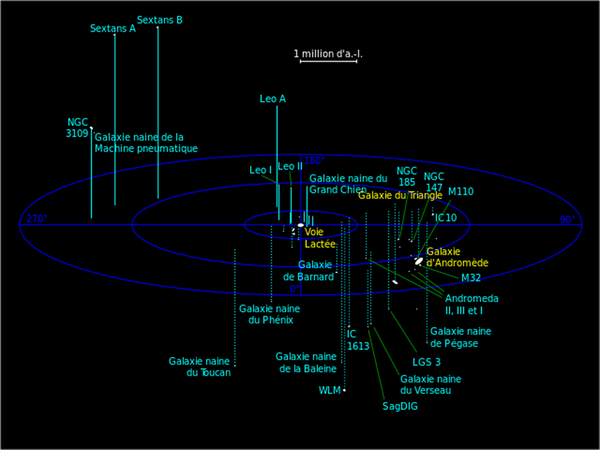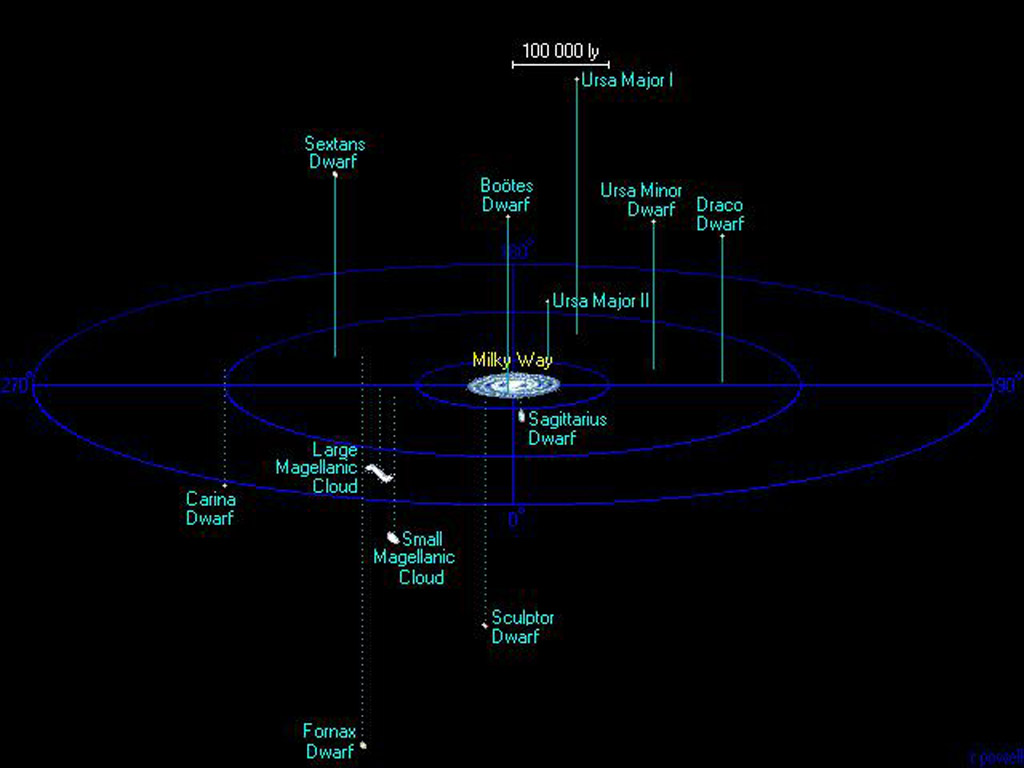
Image description: Some galaxies in our Local Group of galaxies. The Milky Way, the Andromeda Galaxy, the Canis Major Dwarf Galaxy, the Triangulum Galaxy, Barnard's Galaxy, the Pegasus Dwarf Galaxy, the Aquarius Dwarf Galaxy, the Cetus Dwarf Galaxy, the Tucana Dwarf Galaxy, the Phoenix Dwarf Galaxy, the Antlia Dwarf Galaxy. Credit: Richard Powell.
The Local Group (LG) of galaxies is our own galaxy cluster. Although there is plenty of space in the universe, galaxies tend to stick together. The Local Group is a collection of about fifty galaxies, including the Milky Way.
The Local Group spans about 10 million light-years in diameter. In this group, all types of galaxies are present except for giant elliptical galaxies, which are never found in such small structures.
The sphere of space surrounding our galaxy is known as the Local Volume, an area roughly 35 million light-years in diameter that includes several hundred known galaxies.
The two main members of this group are the Andromeda Galaxy (M31) and our Milky Way galaxy, each with its own small group of satellite galaxies.
The Milky Way and Andromeda form a somewhat larger group of 20 galaxies with M33, Maffei I and Maffei II, the Large and Small Magellanic Clouds. All these galaxies move around a common center located between our Galaxy and the Andromeda Galaxy. At 2.5 million light-years away, M31 is the closest galaxy and the only one visible to the naked eye on a dark night. The Local Group is a galaxy cluster containing a relatively small number of objects.
Galaxy clusters can be much larger. If we go down to magnitude 21, there would be 75 million galaxies.
In the universe, structures stack within each other infinitely, and at the level above the Local Group, there is an even larger structure.
The Local Group is part of a vast complex of 10,000 galaxies grouped into clusters extending over about 200 million light-years, called the Local Supercluster or the Virgo Supercluster.
The Virgo Supercluster and the Hydra-Centaurus Supercluster are themselves falling towards another large aggregation of galaxy clusters called the Great Attractor.
Thus, from our satellite, Earth, we are part of a fantastic cosmic ballet: the Earth propels us at 30 km/s around the Sun, which speeds through space at 230 km/s around the Milky Way. In turn, the Milky Way is falling towards the Andromeda Galaxy at 90 km/s, and each of its galaxies is moving at 45 km/s towards the center of the Local Group, our galaxy cluster. The Local Group moves at 600 km/s, attracted by the Virgo cluster and the Hydra-Centaurus Supercluster, which is itself falling towards the Great Attractor.
N.B.:
The word "galaxy" comes from the Greek "galactos," which means "milk," hence the name of our Galaxy: the Milky Way.

Image description: The galaxy M31 (apparent magnitude 3.38) is visible to the naked eye. The stars seen in the foreground are actually stars from our galaxy. At the bottom edge of the disk, you can see its companion, the dwarf galaxy NGC 205 or M110. The bright spot at 10 o'clock near the disk is M32, another satellite galaxy. Credit: Robert Gendler (robgendlerastropics.com)
The Large Magellanic Cloud (LMC) is the largest satellite galaxy of our own Milky Way.
According to an article in *Nature* from March 2013, the Large Magellanic Cloud is located at a distance of 162,983 light-years, with an accuracy of 2.2%.
It measures about 15,000 light-years in diameter. It is the 3rd closest galaxy to the Milky Way after the Canis Major and Sagittarius dwarf galaxies. This galaxy, visible to the naked eye from the southern hemisphere, is accompanied by the Small Magellanic Cloud. It is the 4th largest member of our Local Group, after M31, our Milky Way, and M33. It was named after Ferdinand Magellan's expedition around the Earth.
The southern part of its central bar is connected to the Small Magellanic Cloud by a structure of gas and stars. This structure is called the Magellanic Bridge, a gas bridge linking the Small Magellanic Cloud (SMC) with LMC, proof of the tidal interaction between the galaxies.
The Magellanic Clouds share a common envelope of neutral hydrogen, indicating that they were once gravitationally bound. This gas bridge is a star-forming site.
The Large Magellanic Cloud hosts numerous celestial objects, including the Tarantula Nebula, LMC X-1 (a stellar black hole), LMC X-3 (another stellar black hole), SGR 0526-66, PSR B0540-69 (a young pulsar), but the most famous object in the Large Magellanic Cloud is SN 1987A, the first supernova explosion observed from Earth in February 1987. The star that caused this explosion was Sanduleak -69 202.